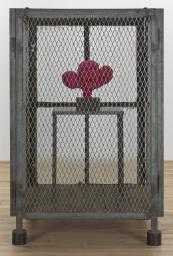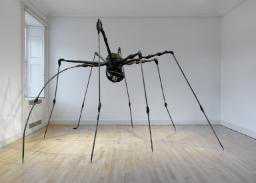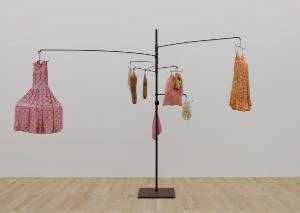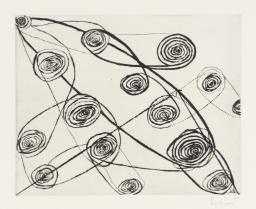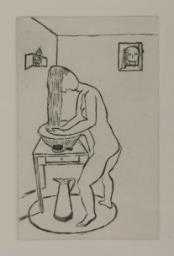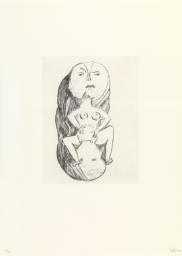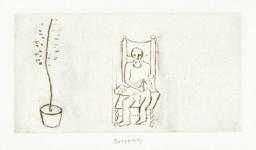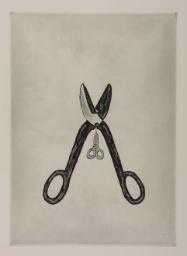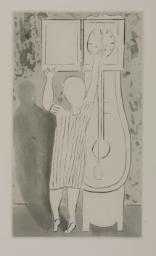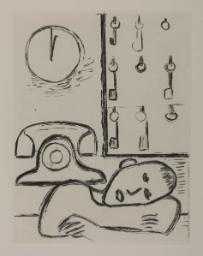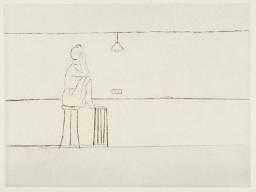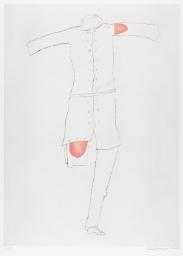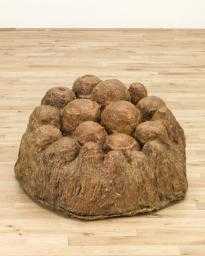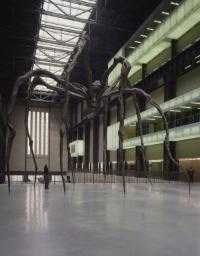
Not on display
- Artist
- Louise Bourgeois 1911–2010
- Medium
- Steel, limestone and glass
- Dimensions
- Unconfirmed: 2362 × 2108 × 2184 mm
- Collection
- Tate
- Acquisition
- Presented by the American Fund for the Tate Gallery 1994
- Reference
- T06899
Summary
Cell (Eyes and Mirrors) is one of a series of installations which Bourgeois began making in 1989. The Cells are typically constructed from a mixture of such salvaged architectural materials as old doors, windows and wire mesh combined with found objects and sculptural fragments. This Cell
has the structure of a cube. The ceiling and two of the walls are made of woven iron mesh joined by iron bars which are hinged in places. The other two walls consist of iron rods welded in a grid holding large square panes of glass so that they resemble oversize windows. Several spaces in the grid are empty of glass. A large round mirror is attached to a hinged circular panel cut out of the centre of the ceiling. The panel rotates to reflect different aspects of the interior.
A large pair of eyes, comprising two polished, black marble eyeballs, stares blankly out of a lump of rough, greyish stone mounted on two sections of steel girder in the centre of the Cell. This sculpture is a later version of a work Bourgeois made in 1984 titled Nature Study (Velvet Eyes) (Collection Galerie Lelong, Zurich). The artist has subsequently developed several versions of eyes carved in marble. As a result of their elemental materials, simple form and large scale, the eyes convey a sense of monumental force, both inviting and repelling the viewer’s gaze. They are surrounded by mirrors of various sizes. Several small mirrors hang off the mesh wall behind them. A large oval-shaped mirror and a small round mirror mounted on tall, old fashioned wood and metal stands are positioned on either side of the eyes. A square mirror is propped on the floor. Breast-like bulges, carved out of the back of the unpolished marble in which the eyes are embedded, are visible through reflection in one of the mirrors. These suggest that the eyes represent a female subject.
The many mirrors create a profusion of reflections and altered perspectives which disrupt any sense of direct perception the eyes would seem to propose. Enclosed within the cage-like structure, the eyes are themselves trapped in a space which offers them for viewing by other eyes – those of the viewer. Bourgeois has stated:
The subject of pain is the business I am in. To give meaning and shape to
frustration and suffering ... The Cells represent different types of pain: the
physical, the emotional and psychological, and the mental and intellectual. When
does the emotional become physical? When does the physical become emotional:
It’s a circle going around and around. Pain can begin at any point and turn in any
direction.
(Quoted in The Secret of the Cells, p.81.)
Bourgeois’s Cells are enclosures from which the viewer is usually excluded physically, but which he or she is invited to penetrate visually. The need and desire to look and the ambiguities inherent in both positions of the one looking and the one being looked at are familiar themes for Bourgeois. Similarly, spaces or forms which provide shelter but also possible entrapment have been present in her work since the 1960s. Toilette and Woman in Bathtub (Tate P77682 and P77691) are two prints in Bourgeois’s Autobiographical Series (1994) depicting voyeurism by another and also of the self. For Bourgeois, mirrors provide a concrete representation of the challenging dynamics involved in looking. She has commented: ‘reality changes with each new angle. Mirrors can be seen as a vanity, but that is not all their meaning. The act of looking into a mirror is really about having the courage it takes to look at yourself and really face yourself.’ (Quoted in The Locus of Memory, p.50.)
Further reading:
Rainer Crone, Petrus Graf Schaesberg, Louise Bourgeois: the Secret of the Cells, Prestel, Munich 1998, p.160, reproduced (colour) p.118
Louise Bourgeois: Recent Works, Musée d’art contemporain de Bordeaux, Bordeaux 1998
Charlotta Kotick, Terrie Sultan, Christian Leigh, Louise Bourgeois: The Locus of Memory, Works 1982-1993, The Brooklyn Museum, New York 1994, pp.26, 49, reproduced p.124
Elizabeth Manchester
July 2001/September 2003
Does this text contain inaccurate information or language that you feel we should improve or change? We would like to hear from you.
Display caption
This is one of several works in which Bourgeois reassembled doors and windowpanes to form small cells. The large marble eyes and the mirrors in this cell indicate that Bourgeois was thinking about voyeurism and surveillance. The mirrors reflect each other and the eyes in an endlessly probing insular circuit.
Gallery label, October 2016
Does this text contain inaccurate information or language that you feel we should improve or change? We would like to hear from you.
Explore
- abstraction(8,615)
-
- from recognisable sources(3,634)
-
- figure(2,270)
- non-representational(6,161)
-
- geometric(3,072)
- emotions and human qualities(5,345)
- furnishings(3,081)
-
- mirror(241)
- actions: processes and functions(2,161)
-
- looking / watching(581)
- eye(269)
- crime and punishment(436)
-
- imprisonment(25)
You might like
-
Louise Bourgeois Cell XIV (Portrait)
2000 -
Louise Bourgeois Spider
1994 -
Louise Bourgeois Untitled
1996 -
Louise Bourgeois Untitled (Safety Pins)
1991 -
Louise Bourgeois Toilette
1994 -
Louise Bourgeois Birth
1994 -
Louise Bourgeois Paternity
1994 -
Louise Bourgeois Scissors
1994 -
Louise Bourgeois Woman and Clock
1994 -
Louise Bourgeois Man, Keys, Phone, Clock
1994 -
Louise Bourgeois Woman in Bathtub
1994 -
Louise Bourgeois Empty Nest
1994 -
Louise Bourgeois Amputee
1998 -
Louise Bourgeois Avenza
1968–9, cast 1992 -
Louise Bourgeois Maman
1999

